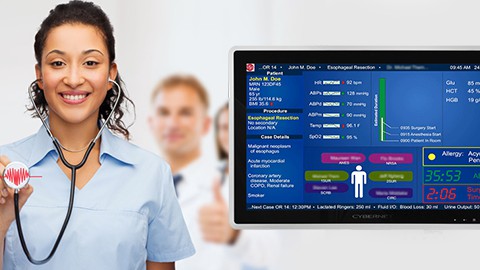Healthcare groups have numerous priorities to juggle when designing a hospital’s layout. They must move patients around efficiently, store supplies in convenient spots, and protect against potential radiological or chemical hazards.
Just as critical as these concerns is giving healthcare providers space to work while not directly treating patients.
For nurses, this means having a dedicated station to fill out paperwork, prepare medication, monitor patients, and more. Properly equipped, a nurses’ station should have all the tools its staff will need throughout a shift.
What Is A Nurses’ Station?
Article Guide
A nurses’ station is a designated workspace within a healthcare facility, providing a central hub for nurses and healthcare staff when not directly attending to patients. It facilitates various duties, enhancing coordination and efficiency in patient care
Nurses’ Station or Nursing Station: Which Is Correct?
While “nurses’ station” and “nursing station” are sometimes used interchangeably, they refer to very different things. Nurses’ stations are fixtures in healthcare facilities; nursing stations are spaces dedicated to letting mothers conveniently breastfeed their babies. Nursing stations are often found in shopping malls, amusement parks, and museums.
Key Personnel at the Nurses’ Station
A nurses’ station is a crucial point of activity at any hospital ward and, therefore, features numerous types of staff working there.
Registered nurses are most often found at nurses’ stations, but other support staff, such as CNAs, LVNs, and hospital aides will also be present. Depending on the station’s location, certain specialists (like cardiologists in a cardiac care unit), may also be present.
Design and Layout of a Typical Nurse’s Station
Given the vital nature of nurses’ tasks, an efficient station design is crucial. Nurses require accessible tools and resources, allowing flexibility to respond to dynamic situations. The two main designs for nurses’ stations are centralized and decentralized.
Centralized Nurses’ Stations
As the name implies, a centralized nurses’ station is at the center of its unit or ward, often for regulatory compliance. For example, in California, each station can handle up to 60 beds and cannot be more than 150 feet from the furthest bed.
From this location, nurses have an easier time monitoring patients and reaching them if an emergency occurs. The station will typically be arranged in a circular or semi-circular fashion, giving nurses a clear view of the unit.
Centralized stations make it easier for other providers, patients, or visitors to find a nurse in case a critical situation develops. If a nurse needs to leave the station they can use a workstation on wheels to bring a computer with them.
Decentralized Nurses’ Station
In a decentralized design, the equipment and infrastructure of a nurses’ station are spread out across several points throughout the floor or ward. These stations typically consist of a medical computer attached to a wall mount and a small cabinet to store supplies.
Decentralized stations are typically located in hallways or alcoves outside a centralized station’s view. They are often placed between two patient rooms, letting nurses assigned to that station monitor patients within the rooms and react more quickly in an emergency.
While decentralized stations enable nurses to cover more ground and accommodate unconventional floor plans, they are not as well-equipped as centralized nurses’ stations. Additionally, nurses working at decentralized stations sometimes report feeling isolated and unable to communicate effectively with other providers.
Enclosed or Open Nurses’ Stations?
Historically, most nurses’ stations have been “open.” In other words, there are no physical barriers like walls or windows between nurses, visitors, and patients.
However, some stations in high-risk areas, such as psychiatric wards, implement protective measures like walls and plexiglass windows to prevent patients from reaching staff. This protects nurses from physical assault and keeps patients from interfering with their workflow.
While enclosed nurses’ stations are undeniably safer for staff, disadvantages exist.
- They limit nurses’ visibility, making it harder to monitor patients in their rooms.
- They can send the wrong message, implying that patients or visitors are dangerous to the staff.
Whether a nurses’ station is open or enclosed will often depend on the size and specialty of the facility in question, the regulations for workplace safety in the area, and patients’ mental acuity.
Typical Nurses’ Station Equipment
A nurses’ station must fully equip personnel with the tools and resources they require throughout their shifts. This equipment includes:
- Computers and Workstations: Medical-grade computers and tablets are used to access electronic health records (EHRs), patient charts, and other digital healthcare systems. These devices should be designed specifically for healthcare settings rather than off-the-shelf consumer-grade options.
- Printers and Scanners: These devices process paper documents like patient records, medication orders, and other essential paperwork. They should be able to print in high resolution, in both black and white and in color, and require minimal maintenance.
- Telephones and Intercoms: Communication tools allowing nurses to contact other parts of the hospital or off-site are critical, especially during an emergency. For these tools, call quality is essential for sharing information without any transmission errors.
- Patient Monitoring Systems: Tracking vital signs, alarms, and other data from patient monitors is critical. This allows nurses to keep an eye on their patients’ conditions while focusing on other tasks.
- Emergency Equipment: Every nurses’ station should have a crash cart with life-saving equipment and medications such as defibrillators, epinephrine, valve masks, and more. This allows nurses to respond to any medical emergencies their patients have quickly.
- Medical Supplies and Storage: Aside from emergency equipment, nurses’ stations should have a stock of supplies for day-to-day usage. Cabinets, shelves, and storage units allow nurses to keep supplies organized while not in use.
- Whiteboards and Bulletin Boards: While many hospitals now use digital work assignment and care planning tools, physical boards are still popular for displaying patient information and station announcements.
- Furniture: Lastly, nurses need chairs or stools to sit on while working to spend some time off their feet.
Selecting the Right Equipment for Your Nurses’ Station
The right equipment is critical for delivering better patient care and keeping staff safe and satisfied. When choosing the tools and supplies for your hospital’s nurses’ stations, keep these factors in mind:
- Workflow and Ergonomics: Hospital equipment is supposed to enhance a provider’s workflow, not impede it. If equipment is cumbersome, slow, or difficult to use, there is probably a better choice. Ergonomically friendly decisions like adjustable chairs and workstations help ensure staff are comfortable and productive during their shift.
- Technology Integration: When choosing a new piece of equipment, ensure it will work seamlessly with your hospital’s pre-existing infrastructure. This includes EHR system compatibility, working alongside communication tools, and other digital healthcare programs.
- Security and Privacy: Healthcare groups are obligated to protect patients’ safety and privacy as best as possible. This includes digital security features like encrypting patient files and physical security features like privacy filters that block prying eyes from peeking at screens.
- Scalability: An essential component of healthcare equipment is its ability to scale and accommodate changes in patient volume and service expansion. For example, can a patient monitoring system track 50 patients as quickly as it does five?
- Ease of Maintenance and Reliability: Hospitals cannot afford to halt operations due to broken-down equipment. Choosing fanless cooling for medical-grade computers eliminates moving parts and ensures better reliability. In addition, hospital equipment must be constantly disinfected to prevent the spread of pathogens. Electronics should be rated IP65 to protect internal components from dust, water, or cleaning agents leaking through the casing.
- Regulatory Compliance: Any electronic equipment used in a medical setting must meet regulatory requirements like IEC 60601 to protect the patient and user from electrical shocks.
Empower Your Nurse Stations With Cybernet
A nurses’ station is perhaps one of the most important parts of any hospital’s ward. A nurses’ station can deliver better patient care results and a better working experience for your providers if adequately equipped and prepared.
If your hospital or healthcare group is interested in acquiring new computers for your nurse stations, contact the team at Cybernet Manufacturing. Our computers and tablets are certified medical-grade and can be customized to meet your needs.
Join the conversation and connect with us on this and other relevant topics!Follow us on Facebook, X, and LinkedIn
Why Fanless Medical Computers are a Must for the Medical Profession
July 9, 2015
The enterprise industries and the healthcare profession have been greatly affected by the increasing use of all-in-one computers and similar devices. The healthcare profession has grown to rely more and more on medical…
0 Comments5 Minutes
Streamlining Nursing Workflows with Medical Computers
May 13, 2021
It’s sometimes easy to overlook, but nurses are, in a very literal sense, the backbone of the healthcare system. In fact, there are more nurses than there are members of any other profession within healthcare.…
0 Comments9 Minutes
You Can't
Learn from a Pop-up
But we can deliver knowledge to your inbox!
We dive deep in the industry looking for new trends, technology, news, and updates. We're happy to share them with you.
Knowledge, News, and Industry Updates Right in Your Inbox




